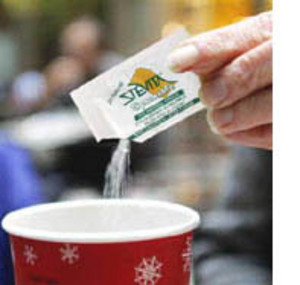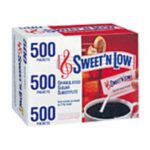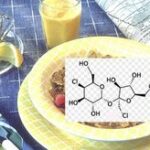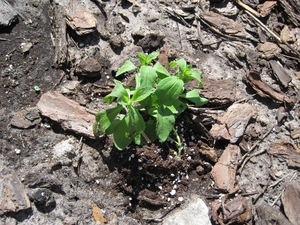Stevia or Stevia rebaudiana is an all natural powdered sweetener. It originated from South America and was first used as a sweetener by the Guarani Indians in Paraguay for many years. It is called sweetleaf and sugar leaf. The powdered form is up to 30 times sweeter than sugar, while it’s extracts can be up to 300 times sweeter than sugar. It has a delicious taste.
If you are already used to the flavor of artificial sweeteners, you will find it very easy to adjust to the flavor of stevia. Stevia has zero calories just like any other artificial sweetner and the most exciting knews is that Stevia is completely natural. It can be used in most cooking recipes, but will not caramelize like sugar so recipes like caramel, would not be possible. It also will not act as fuel for yeast when baking because it’s non-fermentable. It will heat stable to 200 degrees Celsius (392 farenheit).
It should be noted that so far stevia falls in the range of herbs and all natural supplements and is not yet approved by the FDA for food use. So, it would be the equivalent of you taking an herb or supplement such as chamomile or goldenseal. You would be doing so at your own risk. When this is the case if you decide to use stevia for your needs you want to make sure that you purchase the highest quality product you can find to try and ensure your safety. You want to always look for the highest quality products if you choose to use unregulated herbs and supplements.
So far Stevia has been determined safe to use and has been used since pre-Columbian times with no reported side effects such as toxicity. All research projects conducted on stevia have turned up positive results and most people have felt it safe for both human and animal use. Stevia is quite popular in Japan where it has been used for over 35 years as a sweetener.
One remarkable difference between stevia and other artificial sweeteners like Splenda is that stevia has believed health benefits. Though these benefits have not been corroborated by the FDA they are believed to be:
* Will not effect blood sugar levels like sugar does.
* Plaque retardant Anti-caries (prevents cavities)
* Recommended for diabetics
* Non-toxic Extensively tested in animals and Extensively used by humans with no adverse effects.
Splenda is all the buzz these days. Splenda is derived from sugar and often described as a sweetener that tastes very close to sugar. Splenda contains sucralose. This is what causes it to taste so much like sugar. It has the versatility of being used almost anywhere that you would use sugar. Splenda is confirmed by the FDA to have zero calories.
Splenda is made by a unique process:
The process replaces the 3 hydrogen-oxygen groups present in the sugar molecule with 3 chlorine atoms. There is chlorine in many foods that we routinely eat so this is not considered toxic. Chlorine is present in all sorts of products including table salt, mushrooms and lettuce. When chlorine is added to sucrose, sucralose is created. Sucralose passes through the body undetected and is not converted into energy, nor is it considered a carbohydrate. Splenda is considered to taste like sugar with none of the calories.
Splenda is deemed fit for consumption by the FDA and is marketed heavily throughout the world. According to the Splenda website, the saftey of Splenda is well documented.
“The safety of sucralose is well documented in more than 100 scientific studies conducted over a 20-year period. In addition, sucralose and, specifically, the safety data on sucralose, has been reviewed by the U.S. Food and Drug Administration (FDA) and other national regulatory agencies, as well as by international health authorities such as the World Health Organization, and found to be safe for use by all consumers, including children, pregnant women and people with diabetes.
Sucralose has been available in international markets for more than 13 years. The FDA first approved the use of sucralose as a non nutritive sweetener in 1998 and expanded this approval in 1999. Currently, sucralose is permitted for use in over 80 countries and it has never been required to carry any safety information or warning statements on its labeling.”
So all in all it seems that the number of safety studies for Splenda is greater than the known number conducted on stevia (under 20); but stevia has a longer history of safe human use and consumption. Splenda is deemed safe by the FDA and stevia is not.
As far as personal preference goes, it is important to look at all the facts and weigh them. You should also determine your preference by your personal tastes.
I drink diet sodas when I go out. I personally will use Splenda when I go out to eat or go to a friends house, but prefer to use Stevia on my own. Something has always seemed a little odd about artificial sweeteners to me and I’ve often wondered if their overuse could be a problem like using a drug or other such created chemical too often. I don’t avoid their use altogether; but, I try not to overuse them. I personally feel safer using stevia more often and find it to work very well in iced and hot tea. I have not yet cooked with it.







